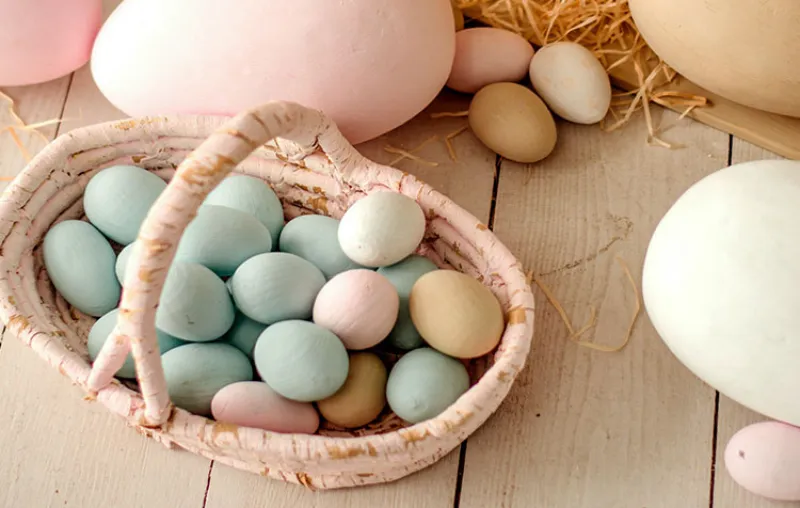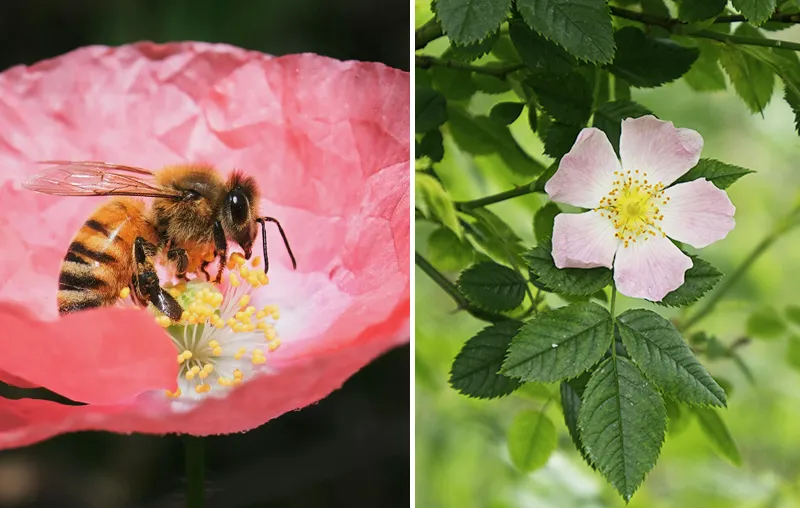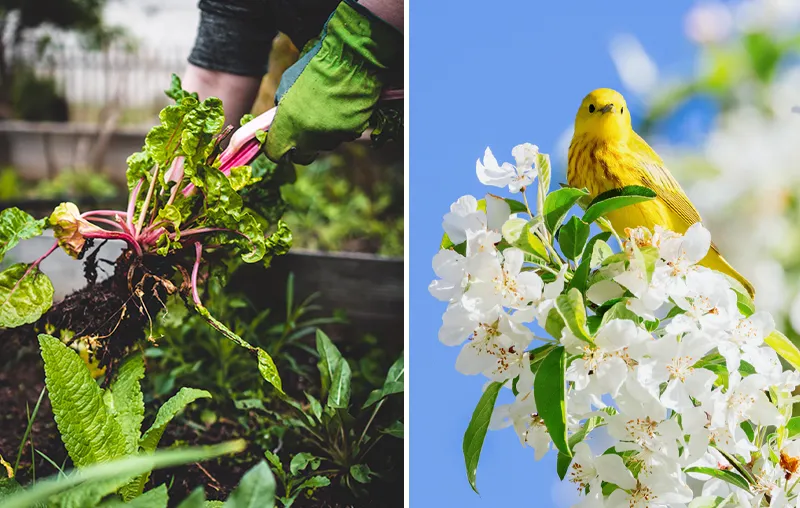You are still looking for Bee-friendly shrubs for your garden? Then you've come to the right place! With native wild shrubs, you can offer wild bees, butterflies, beetles and countless other insects food, protection and a habitat. And best of all: they are also extremely robust, easy to care for and pleasing to the eye!
In this article, I will introduce you to the best bee bushes that will transform any green space into a blooming, buzzing and humming oasis. Place them individually as a bush, for example, or combine them as a hedge. Let's go!
Advantages: Why are beehives so important?
Before we get straight to the exact shrubs, I have a portion of motivation for you!
Here are some very Good ecological and personal reasons that you should equip your garden with a few carefully selected wild shrubs that are indispensable for bees:
- Promote biodiversity: Wild shrubs serve as a habitat for numerous insect species and other garden animals (e.g. spiders and birds). promote ecological diversity.
- Provide a year-round food source: The flowers of native shrubs provide insects with nectar and pollen throughout the seasons.
- Provide shelter and protection: Shrubs provide wind and weather protection and also serve as sheltered nesting sites.
- Networking habitats: Shrubs connect different biotopes and make it easier for pollinators to spread.
- Benefit from low maintenance: Shrubs from our climes are quite undemanding and thrive here without much care, such as additional watering or fertilizer.
- Enjoy natural beauty in the garden: Flowering shrubs create colorful accents, enrich the garden landscape and promote relaxation in your own green space.
- Harvest delicious fruit: Many bee-friendly shrubs offer edible fruit for humans and animals.
10 Shrubs: Which native shrubs are particularly insect-friendly?

Are you motivated? Then let's waste no time and start right away Immerse yourself in the world of insect-friendly shrubswhich in no Natural garden should be missing.
Whether in gardens, parks or open landscapes - Wherever you have the opportunity, plant the following hedgerow shrubs in particular to encourage the bees under their wings and Biodiversity to promote. I will also provide you with the most important facts and show you where you can get the respective plant at a reasonable price.
1. Common Hawthorn (Crataegus monogyna)
The thorny hawthorn is a robust large shrub that can be fragrant white flowers in May and June magnetically attracts over 40 different species of wild bees and countless other insects.
As you can get it not only as a shrub, but alternatively as a standard tree, it also belongs to the most insect-friendly trees. Its dense and thorny branches also provides shelter for birds.
Important facts about the thorny hawthorn:
- Where to buy? Here at the Horstmann nursery* or in the plant trade
- Dimensions: About 4-7 meters high and 4-6 meters wide
- Light: Sun to shade
- Floor: Nutrient-rich garden soil
- Important for: Wild bees, caterpillars, hoverflies, beetles and butterflies
- Other: Hawthorn berries are a valuable source of food for birds and small mammals
2. eared willow (Salix aurita)
The Ohrweide is known for its early flowering yellow catkinswhich provide bees with pollen and nectar in the first few months of the year - a time when only a few plants are in bloom. A must for everyone Bee garden!
Above all, however, the ear willow is a general Insect magnet and provides a habitat for over 250 species (mainly caterpillars and butterflies (e.g. the peacock butterfly)).
Compared to other willows not so big In my opinion, it is also an ideal plant for a wild hedge in smaller gardens.
Important facts about the ear willow:
- Where to buy? Here at the Horstmann nursery* or in the plant trade.
- Dimensions: Up to 2-3 meters high
- Light: Sun to partial shade
- Floor: Normal garden soil, moist
- Important for: Wild bees, caterpillars, butterflies, hoverflies & beetles
- Other: Can be easily propagated with cuttings
3. vine rose (Rosa rubiginosa)
In the world of bee-friendly wild roses the vine rose is definitely one of my favorite plants. With its open, pink flowers and its intense scent of wine and apple, it attracts not only bees but also many other pollinators.
This loose-branched shrub copes well with dry conditions and is a real eye-catcher in every garden.
Important facts about the vine rose:
- Where to buy? Here at the Horstmann nursery* or in the plant trade.
- Dimensions: 1.5-3 meters high and about 2 meters wide
- Light: Sun to partial shade
- Floor: Nutrient-rich, well-drained and dry
- Important for: Wild bees, caterpillars and some hoverflies & beetles
- Other: Thorns and rose hips are important for birds
4. blackthorn (Prunus spinosa)
If you're looking for bee-friendly shrubs, you can't go past the blackthorn. Its beautiful white flowers bloom early in the year from March to May and are extremely important for over 50 species of wild bees and countless other insects.
If you dispense with the core, you can use the even eat the roundish sloes raw. In my opinion, this bee-friendly shrub is a must in every natural garden.
Important facts about sloe:
- Where to buy? Here at the Horstmann nursery* or in the plant trade.
- Dimensions: 1-2.5 meters high and about 2-3 meters wide
- Light: Sun to partial shade
- Floor: Nutrient-rich soil
- Important for: Wild bees, caterpillars, butterflies, hoverflies & beetles
- Other: Important bird protection and bird food tree
5. blackberry (Rubus fruticosus)
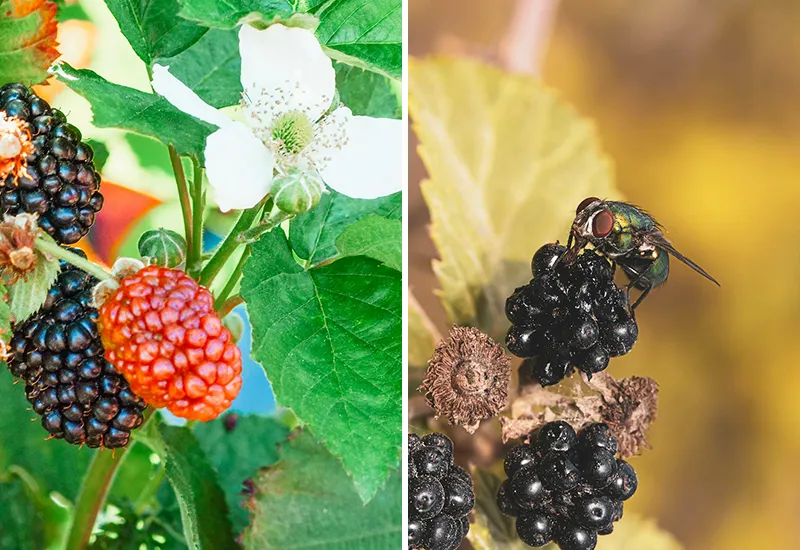
Want more native bee bushes? Then a blackberry bush is perfect for you! Its white blossoms provide plenty of nectar and pollen from June to August for over 50 species of wild bees (e.g. the tree bumblebee) as well as butterflies and many other insects.
At the same time, the dense tendrils and thorns of the blackberry also serve as a sheltered nesting place for birds. In late summer its juicy, dark berries then a valuable food for many garden animals and of course also for us humans.
Important facts about blackberries:
- Where to buy? Here at the Horstmann nursery* or in the plant trade.
- Dimensions: About 2-3 meters high and 1-3 meters wide
- Light: Sun to partial shade
- Floor: Normal garden soil, rich in humus and slightly moist
- Important for: Wild bees, caterpillars, butterflies, hoverflies & beetles
- Other: Ideal natural privacy screen and habitat for birds
Tip: The blackberry is one of the most bee-friendly berry bushes. You can find out which other berries are important for bees and insects in the linked blog post.
6. red honeysuckle (Lonicera xylosteum)
The list of the best shrubs for insects also includes the red honeysuckle, as its delicate white blossoms in the spring, offering a large pollen and nectar buffet. They are visited by the red mason bee, for example.
The dense branches and eye-catching red berries of this easy-care plant are also of great importance to the bird world in summer.
Important facts about the red honeysuckle:
- Where to buy? Here at the Horstmann nursery* or in the plant trade.
- Dimensions: About 2-3 meters high and up to meters wide
- Light: Sun to partial shade
- Floor: Nutrient-rich, humus-rich and slightly moist
- Important for: Wild bees, caterpillars, butterflies, hoverflies and beetles
- Other: Also an important habitat for birds
7. pike rose (Rosa glauca)
With its blue-green leaves and simple pink flowersLike many wild roses, the pike rose serves as an important source of nectar and pollen for a large number of wild bees and other pollinators.
She is quite Undemanding and therefore ideal for low-maintenance gardensin which both insects and birds feel at home.
Important facts about the pike rose:
- Where to buy? Here at the Horstmann nursery* or in the plant trade.
- Dimensions: Up to 3 meters high and wide
- Light: Sun to partial shade
- Floor: Low in nutrients and dry
- Important for: Wild bees, caterpillars, hoverflies and beetles
- Other: Rose hips and thorns also provide a habitat for many native bird species
8. rock pear (Amelanchier ovalis)
In April, the rock pear travels with its white blossoms and thus attracts many bees and other pollinators. Its edible fruits are also an important source of food for birds later in the year.
But pay attention to the Purchase of the insect-friendly small tree but make sure that you use the native form and not the copper rock pear (Amelanchier lamarckii), which originates from North America.
Important facts about the rock pear:
- Where to buy? Here at the Horstmann nursery* or in the plant trade.
- Dimensions: Up to 4 meters high and 3 meters wide
- Light: Sun to partial shade
- Floor: Nutrient-rich and moderately moist
- Important for: Wild bees, caterpillars, butterflies, hoverflies and beetles
- Other: Fruits are popular with birds
9. yellow bladder bush (Colutea arborescens)
Apart from the yellow bladder bush, I have all the shrubs mentioned in this article in my garden. But it won't be long before it joins them. After all, the shrub is an ideal bee pasture and important for over 50 species - also because it blooms bright yellow in clusters from May to October.
Important facts about the yellow bladderwort:
- Where to buy? In well-stocked plant shops.
- Dimensions: Up to 2 meters high and 3 meters wide
- Light: Sun to partial shade
- Floor: Normal garden soil, well-drained and dry
- Important for: Wild bees, caterpillars and beetles
- Other: Often found in parks
10. dog rose (Rosa canina)
Flowering from May to June open pink flowers of the dog rose attract many wild bees as they have a high pollen value. Around 40 different species fly to them.
There are also many other insect species and thanks to the Rose hips and the protective thorns also numerous native birds.
Important facts about the dog rose:
- Where to buy? Here at the Horstmann nursery* or in the plant trade.
- Dimensions: Grows 2-3 meters high and up to 2 meters wide
- Light: Sun to partial shade
- Floor: Nutrient-rich and well-drained
- Important for: Wild bees, caterpillars, butterflies, hoverflies & beetles
- Other: Valuable food source and important nesting site for birds
Plant bee-friendly shrubs in your own garden!
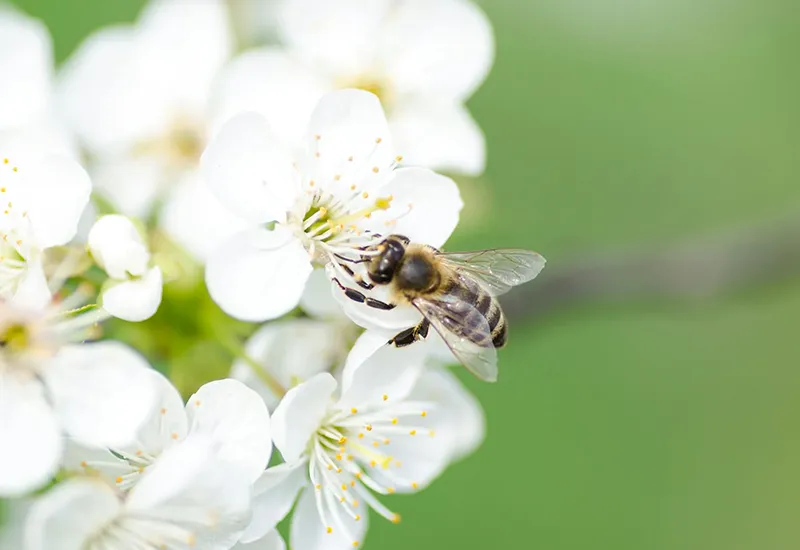
Now you have really gotten to know many native wild shrubs that bees and other insect species love. Find suitable places where you can specifically place them to attract the Stop insect mortality.
Incidentally, there are many other hedge shrubs for the bee world, such as the Broom (Cytisus scoparius) or Alpine golden rain (Laburnum alpinum) - to name them all would have gone beyond the scope of this article.
In any case, I wish you now or in the near future to live in a colorful garden full of life with wonderful Sounds of nature like the The buzzing of bees find real relaxation 🙂
Perhaps you've now got a real taste for a natural garden! If so, I can only warmly recommend the book "Wild & colorful: Designing natural gardens with native plants" by Simone Kern, which you can get here*.
"If the bee disappeared off the surface of the globe, then man would have only four years of life left. No more bees, no more pollination, no more plants, no more animals, no more man."
Albert Einstein (more under Species protection quotes)
Do you have any questions, suggestions or bee-friendly shrubs in your garden that you can recommend? Then write me a comment!
Stay environmentally conscious,

PS: Did you know that around three quarters of all wild bee species nest in the ground? With a self-built sandarium you can therefore help them a lot. I'll show you what this is and how you can build it in the linked blog post.



